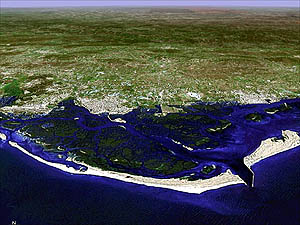Difference between revisions of "Disturbance prevention"
From Coastal Wiki
Dronkers J (talk | contribs) |
|||
| (5 intermediate revisions by 2 users not shown) | |||
| Line 1: | Line 1: | ||
| − | {{ | + | {{ Definition|title= Disturbance prevention |
| + | | definition = The dampening of environmental disturbances by biogenic structures<ref>Beaumont, N.J.; Austen, M.C.; Atkins, J.P.; Burdon, D.; Degraer, S.; Dentinho, T.P.; Derous, S.; Holm, P.; Horton, T.; van Ierland, E.; Marboe, A.H.; Starkey, D.J.; Townsend, M.; Zarzycki, T. (2007). Identification, definition and quantification of goods and services provided by marine biodiversity: implications for the ecosystem approach. Mar. Pollut. Bull. 54(3): 253-265 </ref>..}} | ||
| − | + | ||
| − | + | [[Image:Uses2.jpg|thumb|right]]Living marine flora and fauna can play a valuable role in the defence of coastal regions i.e. [[disturbance prevention]]. Marine ecosystems and the presence of organisms in the front line of sea defence can dampen and prevent the impact of tidal surges, storms and floods providing a 'buffering' effect that protects humans from the effects of these destructive perturbations. This disturbance alleviaion service is provided mainly by a diverse range of species which bind and stabilise sediments and create matural sea grass defences, for example salt marshes, mangrove forests and sea grass beds (Huxley, 1992<ref> Huxley, A. 1992. The new RHS Dictionary of Gardening. MacMillian Press, ISBN 0-333-47494-5Wetlands and floodplains, for example, can help to alleviate the effects of floods by trapping stormwater.</ref>; Davison & Hughes, 1998<ref> Davison, D.M. and Hughes, D.J., 1998. Zostera Biotopes volume I. An Overview of Dynamics and Sensitivity Characteristics for COnservation Management of Marine SACs. Scottish Association for Marine Science UK Marine SACs Project. 95pp.</ref>) | |
| − | [[Image:Uses2.jpg|thumb| | + | |
| + | |||
| + | == References == | ||
| + | |||
| + | <references/> | ||
Latest revision as of 08:54, 24 July 2019
Definition of Disturbance prevention:
The dampening of environmental disturbances by biogenic structures[1]..
This is the common definition for Disturbance prevention, other definitions can be discussed in the article
|
References
- ↑ Beaumont, N.J.; Austen, M.C.; Atkins, J.P.; Burdon, D.; Degraer, S.; Dentinho, T.P.; Derous, S.; Holm, P.; Horton, T.; van Ierland, E.; Marboe, A.H.; Starkey, D.J.; Townsend, M.; Zarzycki, T. (2007). Identification, definition and quantification of goods and services provided by marine biodiversity: implications for the ecosystem approach. Mar. Pollut. Bull. 54(3): 253-265
- ↑ Huxley, A. 1992. The new RHS Dictionary of Gardening. MacMillian Press, ISBN 0-333-47494-5Wetlands and floodplains, for example, can help to alleviate the effects of floods by trapping stormwater.
- ↑ Davison, D.M. and Hughes, D.J., 1998. Zostera Biotopes volume I. An Overview of Dynamics and Sensitivity Characteristics for COnservation Management of Marine SACs. Scottish Association for Marine Science UK Marine SACs Project. 95pp.
